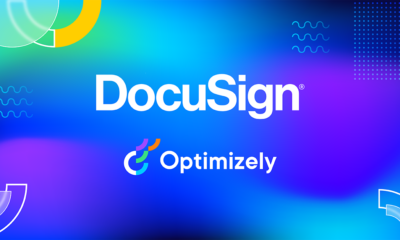TECHNOLOGY
Disruptions Constantly Change the Insurance Industry

What Jake and Flo Aren’t Telling Us: Disruptions Constantly Change the Insurance Industry
Auto and home insurance bundles, umbrella policies, constant arguments about paying for healthcare (especially during a pandemic), and thousands of streaming and social commercial advertisements pushing different providers as being the best option for the average Joe and Jane.
Yes, we are talking about insurance and its many pros and cons. But what Flo from Progressive, the Geico Gecko, and the ever-popular Jake from State Farm may not be able to tell you is where the insurance industry is heading. And truth be told, you do not need them to do so — you can use your own Anticipatory mindset to decode the disruptions that will change the insurance industry from this point forward.
As a consumer, this general concept may strike fear into your heart — or, conversely, bring much-needed relief. It is no secret whatsoever that the consumer-facing side of the insurance sector is complicated, no matter how easy advertisements and salespeople try to convince individual consumers the process of obtaining insurance will be. Disruptions — and better yet, digital disruptions — that turn the insurance industry on its head are meant to ease the common pain points customers face.
And as an insurance professional or a business owner in the insurance industry, digital disruptions should bring you joy — your life will be easier, your customers will be happier, and most importantly, new doors will open to better opportunities to help the masses and scale your organization. However, those who fear these new digital disruptions do so because they feel them to be unpredictable and earth-shattering.
The Real Problem: Life Changes Drive Insurance Changes
Getting in front of any type of digital disruption is easy, as has been demonstrated by my Anticipatory Leader System. But those in the insurance industry, just as in all other industries, who do not embrace the principles of an Anticipatory mindset are frequently left to dread disruption and change.
One of my favorite principles from my Anticipatory Leader System is the Skip It Principle, because it is a straightforward way to start to peel the onion of an issue that shakes up your reality. With the Skip It Principle, we shift our focus from the perceived problem to the actual problem that a digital or other disruption introduces.
In the case of the insurance industry, the real problem is not that accelerated digital technology is transforming how we buy, sell, and implement insurance — it is the fact that change happens in life, period!
Think about that for a second: Insurance is an industry built on the very idea of constant, variable change. Unpredictable change is why we have insurance, is it not? Because we cannot literally use a crystal ball to see what is coming, we pay money to be covered if something goes wrong. The very concept of insurance is Anticipatory, in and of itself! So digital disruptions are not the problem here — the real problem is just a mindset issue.
Insurance agents and other professionals do not actually fear change in general, as the promise of change brings them business — but they do fear change that could disrupt them. Similarly, many customers of insurance fear change in the industry because they worry that these changes will make the process of acquiring insurance even more complex and convoluted, leaving them with lackluster coverage despite their best efforts and investments.
New Digital Disruptions Improving the Insurance Industry
As a business professional in insurance, it is your job to ease the minds of your customers — and, moreover, to follow through with ensuring that your promises of more efficient and accurate experiences with insurance hold true. To perform these tasks, you must use an Anticipatory mindset to identify exactly what digital disruptions are impacting the insurance industry going forward, and how they impact your customers.
Let’s identify a concept and an applicable disruptive digital technology that is transforming a multitude of industries already. This way, we can pre-solve any customer and organizational problems this technology will bring to the insurance industry and prepare for what is to come, just as you do for your clients in creating policies that anticipate and help them to meet their insurance needs.
Omni-Channel Claims Experience — I interviewed Richard Berkman of IBM’s retail technology about omni-channel intelligent commerce. The convergence of a business’s digital technology user experience and its customers’ experience in the physical world is not solely constrained to retail, as evidenced by the ways the principles of omni-channel intelligent commerce are impacting insurance providers and their consumers.
Creating an omni-channel claims experience with an insurance agent or agency means streamlining the interactions that follow an actual, physical incident, when the need to file an insurance claim arises. Everything sounds wonderful on paper when the risks discussed are purely theoretical, but when an incident occurs, the integration of the policy, the insurance agent, and the resolution following an incident must be as seamless as the customer’s experience buying a product online or in-person at a physical location.
There are several technologies already disrupting the likes of retail and service-based industries, designed to create connected and seamless experiences, both virtual and in-person. Disruptions in the insurance industry surrounding this concept are already under way, driven most notably by Internet of Things (IoT) applications and telematics.
Internet of Things (IoT) Risk Assessments — With edge computing, 5G connectivity, and the ability to process more and more data in real time, we are reaching a point in the insurance industry where we can adjust rates by the minute! For example, what was once simply a perk of having a tracker in your car measuring your driving habits and ultimately helping you lower your premiums by making you a safer driver is now finding its way in your home, place of business, and more.
The proactive way insurance companies are already using IoT applications in homes and commercial spaces, for instance, includes predicting when an issue is more likely to take place, like a pipe bursting or a fire starting. This technology alerts the customer of the elevated risk and enables him or her to actually prevent the incident from happening to have them avoid filing a claim for damage to begin with. Talk about pre-solving using anticipation!
Overall, the point of a seamless customer and insurance agency experience is found in a connected experience, whereas legacy systems and legacy mindsets of insurance agencies reflect a passive product that a customer is simply required by law to have. Now customers feel interactive with their insurance, and it removes the top-down emotions once commonplace in the industry.
What Might This Do For You as an Agent?
Naturally, with every digital disruption that improves the customer’s experience, there is the pertinent fear that your status quo will be upended — or, in some cases, eliminated completely. I’d love to tell you that this is not true, but it is a Hard Trend future certainty that you cannot avoid.
However, the beauty of anticipation is that you stay ahead of these disruptions and foresee many of the idiosyncrasies that can and likely will disrupt you as an agency owner or insurance representative. In this case, knowing that increased connectivity is causing the disruptions we discussed in this blog, what aspects of your operation can you pinpoint as likely to be transformed by IoT, edge computing, or autonomous technology that processes customer data?
Insurance, like every other industry in the commercial world, is a Both/And industry, meaning that legacy systems are not completely irrelevant in the wake of new, transformative technology, much as human beings will not be replaced by machines. The skills you have developed as a professional in the insurance industry are still extremely valid, and an Anticipatory mindset will teach you how to help them converge with the new systems and changes coming now and in the future.
Learn to be Anticipatory with my Anticipatory Leader System today!
Source link
TECHNOLOGY
Next-gen chips, Amazon Q, and speedy S3

AWS re:Invent, which has been taking place from November 27 and runs to December 1, has had its usual plethora of announcements: a total of 21 at time of print.
Perhaps not surprisingly, given the huge potential impact of generative AI – ChatGPT officially turns one year old today – a lot of focus has been on the AI side for AWS’ announcements, including a major partnership inked with NVIDIA across infrastructure, software, and services.
Yet there has been plenty more announced at the Las Vegas jamboree besides. Here, CloudTech rounds up the best of the rest:
Next-generation chips
This was the other major AI-focused announcement at re:Invent: the launch of two new chips, AWS Graviton4 and AWS Trainium2, for training and running AI and machine learning (ML) models, among other customer workloads. Graviton4 shapes up against its predecessor with 30% better compute performance, 50% more cores and 75% more memory bandwidth, while Trainium2 delivers up to four times faster training than before and will be able to be deployed in EC2 UltraClusters of up to 100,000 chips.
The EC2 UltraClusters are designed to ‘deliver the highest performance, most energy efficient AI model training infrastructure in the cloud’, as AWS puts it. With it, customers will be able to train large language models in ‘a fraction of the time’, as well as double energy efficiency.
As ever, AWS offers customers who are already utilising these tools. Databricks, Epic and SAP are among the companies cited as using the new AWS-designed chips.
Zero-ETL integrations
AWS announced new Amazon Aurora PostgreSQL, Amazon DynamoDB, and Amazon Relational Database Services (Amazon RDS) for MySQL integrations with Amazon Redshift, AWS’ cloud data warehouse. The zero-ETL integrations – eliminating the need to build ETL (extract, transform, load) data pipelines – make it easier to connect and analyse transactional data across various relational and non-relational databases in Amazon Redshift.
A simple example of how zero-ETL functions can be seen is in a hypothetical company which stores transactional data – time of transaction, items bought, where the transaction occurred – in a relational database, but use another analytics tool to analyse data in a non-relational database. To connect it all up, companies would previously have to construct ETL data pipelines which are a time and money sink.
The latest integrations “build on AWS’s zero-ETL foundation… so customers can quickly and easily connect all of their data, no matter where it lives,” the company said.
Amazon S3 Express One Zone
AWS announced the general availability of Amazon S3 Express One Zone, a new storage class purpose-built for customers’ most frequently-accessed data. Data access speed is up to 10 times faster and request costs up to 50% lower than standard S3. Companies can also opt to collocate their Amazon S3 Express One Zone data in the same availability zone as their compute resources.
Companies and partners who are using Amazon S3 Express One Zone include ChaosSearch, Cloudera, and Pinterest.
Amazon Q
A new product, and an interesting pivot, again with generative AI at its core. Amazon Q was announced as a ‘new type of generative AI-powered assistant’ which can be tailored to a customer’s business. “Customers can get fast, relevant answers to pressing questions, generate content, and take actions – all informed by a customer’s information repositories, code, and enterprise systems,” AWS added. The service also can assist companies building on AWS, as well as companies using AWS applications for business intelligence, contact centres, and supply chain management.
Customers cited as early adopters include Accenture, BMW and Wunderkind.
Want to learn more about cybersecurity and the cloud from industry leaders? Check out Cyber Security & Cloud Expo taking place in Amsterdam, California, and London. Explore other upcoming enterprise technology events and webinars powered by TechForge here.
TECHNOLOGY
HCLTech and Cisco create collaborative hybrid workplaces

Digital comms specialist Cisco and global tech firm HCLTech have teamed up to launch Meeting-Rooms-as-a-Service (MRaaS).
Available on a subscription model, this solution modernises legacy meeting rooms and enables users to join meetings from any meeting solution provider using Webex devices.
The MRaaS solution helps enterprises simplify the design, implementation and maintenance of integrated meeting rooms, enabling seamless collaboration for their globally distributed hybrid workforces.
Rakshit Ghura, senior VP and Global head of digital workplace services, HCLTech, said: “MRaaS combines our consulting and managed services expertise with Cisco’s proficiency in Webex devices to change the way employees conceptualise, organise and interact in a collaborative environment for a modern hybrid work model.
“The common vision of our partnership is to elevate the collaboration experience at work and drive productivity through modern meeting rooms.”
Alexandra Zagury, VP of partner managed and as-a-Service Sales at Cisco, said: “Our partnership with HCLTech helps our clients transform their offices through cost-effective managed services that support the ongoing evolution of workspaces.
“As we reimagine the modern office, we are making it easier to support collaboration and productivity among workers, whether they are in the office or elsewhere.”
Cisco’s Webex collaboration devices harness the power of artificial intelligence to offer intuitive, seamless collaboration experiences, enabling meeting rooms with smart features such as meeting zones, intelligent people framing, optimised attendee audio and background noise removal, among others.
Want to learn more about cybersecurity and the cloud from industry leaders? Check out Cyber Security & Cloud Expo taking place in Amsterdam, California, and London. Explore other upcoming enterprise technology events and webinars powered by TechForge here.
TECHNOLOGY
Canonical releases low-touch private cloud MicroCloud

Canonical has announced the general availability of MicroCloud, a low-touch, open source cloud solution. MicroCloud is part of Canonical’s growing cloud infrastructure portfolio.
It is purpose-built for scalable clusters and edge deployments for all types of enterprises. It is designed with simplicity, security and automation in mind, minimising the time and effort to both deploy and maintain it. Conveniently, enterprise support for MicroCloud is offered as part of Canonical’s Ubuntu Pro subscription, with several support tiers available, and priced per node.
MicroClouds are optimised for repeatable and reliable remote deployments. A single command initiates the orchestration and clustering of various components with minimal involvement by the user, resulting in a fully functional cloud within minutes. This simplified deployment process significantly reduces the barrier to entry, putting a production-grade cloud at everyone’s fingertips.
Juan Manuel Ventura, head of architectures & technologies at Spindox, said: “Cloud computing is not only about technology, it’s the beating heart of any modern industrial transformation, driving agility and innovation. Our mission is to provide our customers with the most effective ways to innovate and bring value; having a complexity-free cloud infrastructure is one important piece of that puzzle. With MicroCloud, the focus shifts away from struggling with cloud operations to solving real business challenges” says
In addition to seamless deployment, MicroCloud prioritises security and ease of maintenance. All MicroCloud components are built with strict confinement for increased security, with over-the-air transactional updates that preserve data and roll back on errors automatically. Upgrades to newer versions are handled automatically and without downtime, with the mechanisms to hold or schedule them as needed.
With this approach, MicroCloud caters to both on-premise clouds but also edge deployments at remote locations, allowing organisations to use the same infrastructure primitives and services wherever they are needed. It is suitable for business-in-branch office locations or industrial use inside a factory, as well as distributed locations where the focus is on replicability and unattended operations.
Cedric Gegout, VP of product at Canonical, said: “As data becomes more distributed, the infrastructure has to follow. Cloud computing is now distributed, spanning across data centres, far and near edge computing appliances. MicroCloud is our answer to that.
“By packaging known infrastructure primitives in a portable and unattended way, we are delivering a simpler, more prescriptive cloud experience that makes zero-ops a reality for many Industries.“
MicroCloud’s lightweight architecture makes it usable on both commodity and high-end hardware, with several ways to further reduce its footprint depending on your workload needs. In addition to the standard Ubuntu Server or Desktop, MicroClouds can be run on Ubuntu Core – a lightweight OS optimised for the edge. With Ubuntu Core, MicroClouds are a perfect solution for far-edge locations with limited computing capabilities. Users can choose to run their workloads using Kubernetes or via system containers. System containers based on LXD behave similarly to traditional VMs but consume fewer resources while providing bare-metal performance.
Coupled with Canonical’s Ubuntu Pro + Support subscription, MicroCloud users can benefit from an enterprise-grade open source cloud solution that is fully supported and with better economics. An Ubuntu Pro subscription offers security maintenance for the broadest collection of open-source software available from a single vendor today. It covers over 30k packages with a consistent security maintenance commitment, and additional features such as kernel livepatch, systems management at scale, certified compliance and hardening profiles enabling easy adoption for enterprises. With per-node pricing and no hidden fees, customers can rest assured that their environment is secure and supported without the expensive price tag typically associated with cloud solutions.
Want to learn more about cybersecurity and the cloud from industry leaders? Check out Cyber Security & Cloud Expo taking place in Amsterdam, California, and London. Explore other upcoming enterprise technology events and webinars powered by TechForge here.
-

 PPC5 days ago
PPC5 days ago19 Best SEO Tools in 2024 (For Every Use Case)
-

 MARKETING7 days ago
MARKETING7 days agoStreamlining Processes for Increased Efficiency and Results
-
SEARCHENGINES6 days ago
Daily Search Forum Recap: April 17, 2024
-

 PPC7 days ago
PPC7 days ago97 Marvelous May Content Ideas for Blog Posts, Videos, & More
-

 SEO7 days ago
SEO7 days agoAn In-Depth Guide And Best Practices For Mobile SEO
-
SEARCHENGINES5 days ago
Daily Search Forum Recap: April 18, 2024
-

 MARKETING6 days ago
MARKETING6 days agoEcommerce evolution: Blurring the lines between B2B and B2C
-
SEARCHENGINES4 days ago
Daily Search Forum Recap: April 19, 2024












![Amazon Trends & Industry Predictions for Sellers [2024] Amazon Trends & Industry Predictions for Sellers [2024]](https://articles.entireweb.com/wp-content/uploads/2024/01/Amazon-Trends-Industry-Predictions-for-Sellers-2024.webp-400x240.webp)
![Amazon Trends & Industry Predictions for Sellers [2024] Amazon Trends & Industry Predictions for Sellers [2024]](https://articles.entireweb.com/wp-content/uploads/2024/01/Amazon-Trends-Industry-Predictions-for-Sellers-2024.webp-80x80.webp)


You must be logged in to post a comment Login